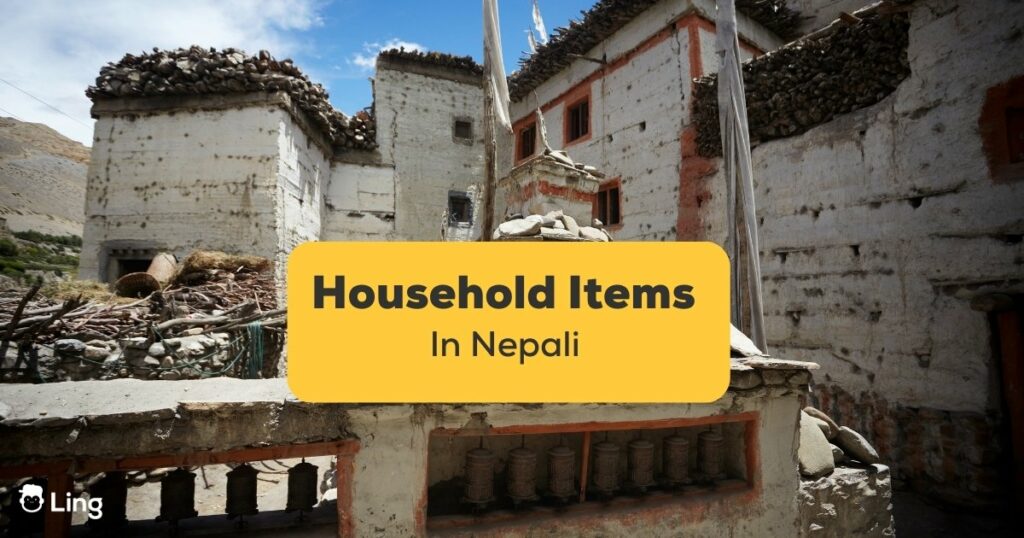They say household items can tell a lot about one’s cultural uniqueness. So, today, let us take some time to learn Nepali household items vocabulary to know what makes a traditional Nepali home style special. Especially if you are traveling to Nepal for this holiday season, you will find this blog quite interesting. You can use it as your own Nepal trip dictionary. If you are interested, continue reading.
Learning a few Nepali vocabulary related to house (घर) (Ghara) items can help you in many ways, from navigating your things inside your room in your Nepali accommodation, and repairing things, to even buying one. Although Nepali people are not used to visitors speaking their native language, you can use basic vocabulary to engage in small talk and broaden your language skills while exploring Nepali culture. So, with today’s post, where we will learn Nepali vocabulary related to house items and some facts about the local culture, you will become well-equipped with all the essentials that will let you experience a native vacation!
Nepali Traditional House
Before starting with our Nepali words, let us take a quick peek at the traditional Nepali home style.
If you have seen movies, you might have a blurry idea of what Nepali houses usually look like. Well, it is not far from reality. Most traditional Nepali houses have wall designs of thick stones and a thatched roof of tin, gravel, or hay. They are primarily double-stored houses with a paste of clay as their paint coat. The reason behind the double-stored house is the agricultural economy of Nepal. Since Nepal is filled with farmers, most homes in the ethnic villages have enough space built for storing grains, wood, food preparation, machines, etc. Some houses also have wooden pillars to add a sign of luxury.
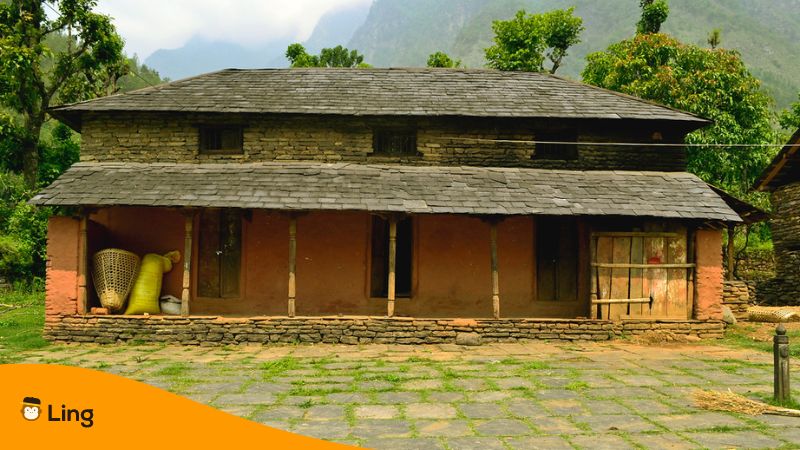
Although a stone wall house is typical in most villages in Nepal, with urbanization, urban homes got their birth. Like western society, Nepali houses have now evolved into single-family houses in the town areas. The house is made of bricks and cement and has its own gate, a compound, and a boundary. The house is not built around the farmer’s farm of available natural land; the owner has full rights over that land through purchasing power.
Another common type of house in Nepal and its neighboring country, India, is Bungalow. Although Nepal doesn’t actually have places that define a bungalow conventionally, locals commonly use this word to refer to a specific type of house. Thus, in the Nepali dictionary, a Bungalow is a single-family house with more expansive verandas, extensive lawns, sloping roofs, and dormer windows. In simple words, it can be any house that is bigger than usual.
Nepali Household Items Vocabulary
Now, let us start with a few Nepali vocabulary translations of the different items a local owns. Learning these encourages language development, making you a pro-Nepali language speaker.
1. House
Translation: घर
The first word we need to get our hands on is घर- Ghara. Most traditional houses are called Ghara, widely used to describe any place, be it a bungalow or a multi-story house. The same word is used to describe a home. There is no specific translation for that word. However, you can also use the term सदन- Sadana to describe a house in the Nepali language.
2. Table
Translation: तालिका
Just like any other house, Nepali houses also have तालिका- Tālikā as a primary object. Different tables are used to dine with the family, read newspapers, and study. Most tables are made of wood, and glass designs are only seen in urban houses. In fact, most rural homes don’t have tables and prefer settling on the floor.
3. Bed
Translation: ओछ्यान
Another common item found in Nepali households is the bed. Well, if we talk about urban houses, ओछ्यान- Ōchyāna is an inevitable part of the house bedroom. However, in villages, some still practice sleeping on mattresses or over a bedsheet spread on the floor. So, if you book a traditional homestay, you might get to sleep in one of the unique beds made on the floor instead of the conventional one.
4. Buddhist Painting
Translation: थाङ्का
One of the most precious things in Nepali households is the थाङ्का- Thangka. It is a Buddhist painting made on a piece of cotton or silk cloth. They are usually hung on the walls in a dry place as the work can be very delicate, and moisture can destroy the texture. The paintings typically depict Buddhist deities or religious scenes. It is used both as a devotional and decorative piece.
5. Singing Bowls
Translation: दबका/ बाटा
If you have never seen a दबका/ बाटा- dabaka or bata before, you will indeed be surprised. It is a common item kept in Nepali homes as a decorative piece but is mainly used by monks during their meditation practices. It is a type of thick brass pot that produces vibration with a deep tone when hit by a wooden rolling board or played with by a wooden stick. It is believed to stimulate relaxation and healing properties.
6. Flat Round Woven Tray
Translation: नाङ्लो
Coming to kitchen utensils, a flat round woven tray or नाङ्लो- Nāṅlō is one of the most common everyday utensils seen in a traditional household in Nepal. It is usually used to prepare rice grains and remove foreign particles, wash fruits and vegetables, and hold other eating utensils. This kitchen utensil is mainly made of bamboo and wood in villages of Nepal.
7. Ladle
Translation: दाउ
Another common cooking utensil in the Nepali kitchen is the दाउ- Daadu. It is a long metal scoop similar to a ladle. A daadu is mainly used for serving soups, especially lentil soup, which is one of the traditional Nepali foods. It is also used to serve curried dishes from the bigger pot to the serving plates.
8. Machete
Translation: खुकुरी
A fascinating item that you will find in almost every Nepali house is the खुकुरी- Khukurī. It is a machete type with a unique recurve in its blade. The handle can have many designs made of wood and leather. It is known as Nepal’s national weapon and is used daily as a tool. However, most houses keep unique Khukurī as decorative pieces and are used for religious and ceremonial practices. Such items in local markets become a great tourist attraction.
9. Sofa
Translation: सोफा
Coming back to more normal things, you will undoubtedly see a सोफा- Sōphā in your Nepali room. However, the unique thing about them is that the sofas are mostly made of wood. Unlike the cushiony couches of western houses, most Nepali households own sofas with an entirely wooden-based structure with detachable cushions. They are also usually painted brown, or the natural colour is magnified through varnish paint.
10. Tibetan Prayer Flags
Translation: लुङ्ग ता/ डार्चोग
A Tibetan prayer flag or the Lung ta (Horizontal ones)/ Darchog (Verticle ones) is a traditional item in Nepal. These are colourful rectangular flags held together in a string and are culturally used to promote peace, strength, and compassion. Each flag contains a mantra, which is believed to spread goodwill among the Nepali people.
Bedroom Items In The Nepali Language
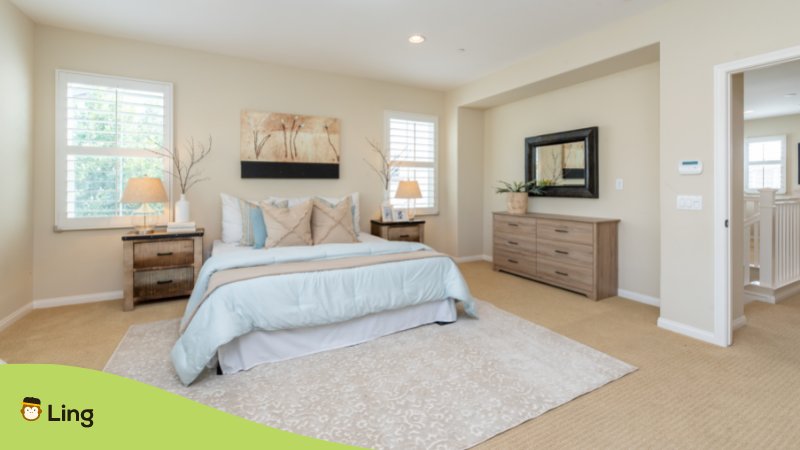
Bathroom Items In Nepali
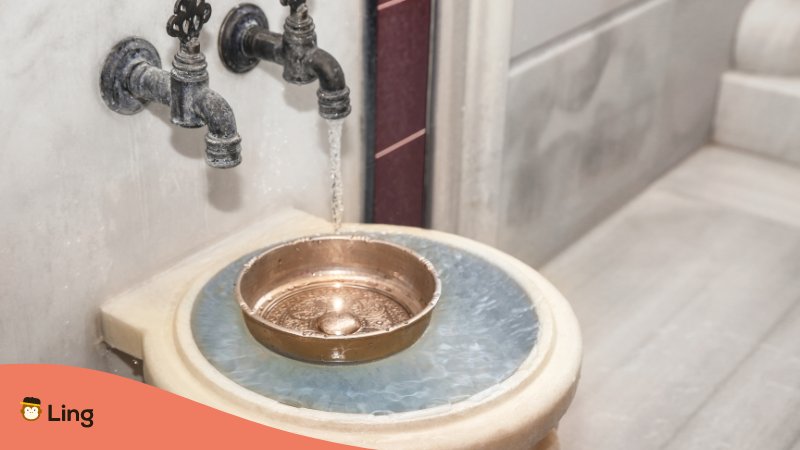
Nepali Words Of Livingroom Items
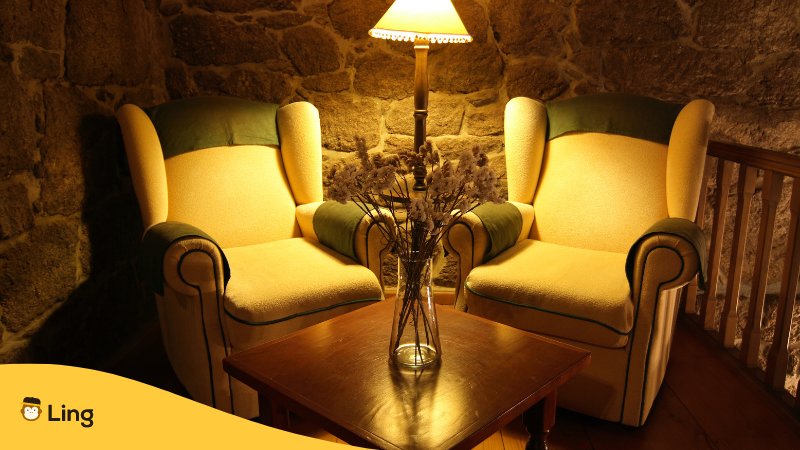
Nepali Vocabulary Terms For Kitchen Items
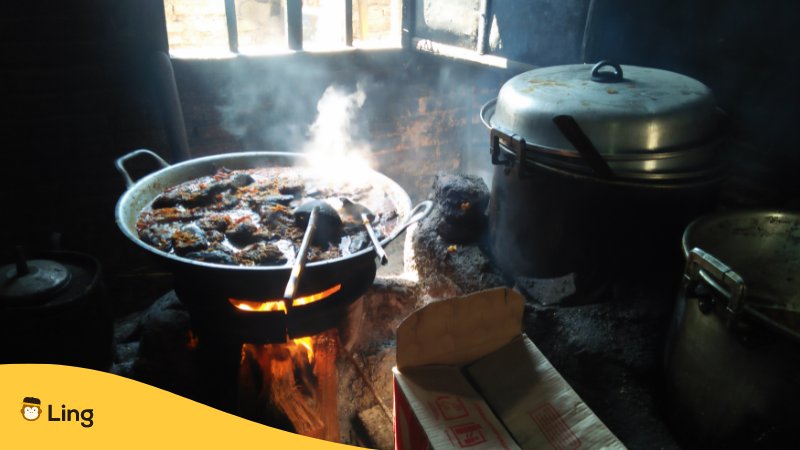
Nepali Phrases Related To Household Items
Wrapping Up!
Isn’t it fun to dig into different utensils, objects, and items used in Nepali households? The vocabulary practice makes you a fluent speaker of the Nepali language, which will help you explore and connect with the locals effortlessly. It can be a hassle to travel to a new country that does not speak your native language. But with these particular words, you are already on your way to making changes.
So, if you wish to continue learning other English-Nepali articles, the Ling app is here to help you. You can find the app on Appstore and Playstore and use it on your chosen device. Download to make Nepali learning easy!
Learn With Ling App

Ling is one the best sources of learning new languages. The Ling app supports 60+ languages; you can choose your target language and know it for free. It provides content on various topics, such as Nepali food, culture, clothes, room terms, hobbies, etc., through informative blog posts.
The most exciting part is that the app includes artificial intelligence like the AI chatbot, linguistic games, images matching to the corresponding word, and fun quizzes that improves your communication skills through speaking practice and real-life conversation. If you are like most language learners keen to know more daily, download the app now and learn Nepali immediately!
